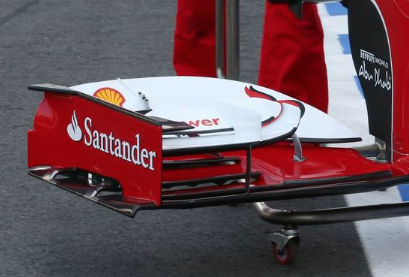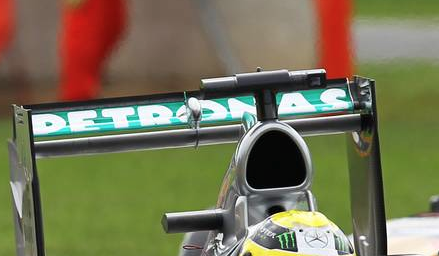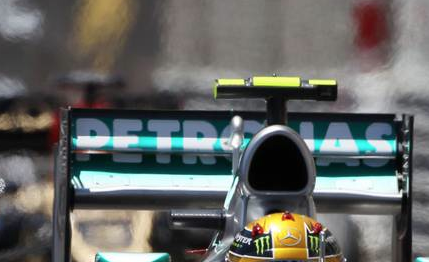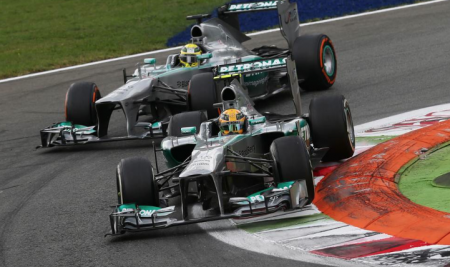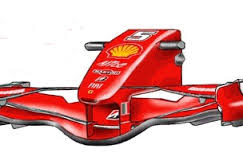What Makes Monza Different?
Posted: 08/09/2014 in aero, aerodynamics, cars, F1, Ferrari, FIA, Formula One, Grand Prix, hamilton, imola, Italian Grand Prix, Monza, racing, UncategorizedTags: aero, aerodynamics, f1, formula one, grand prix, mass, physics, racing, velocity, weight
The building of the high banked turn
Did you know that having hosted all but one Italian Grand Prix since 1950, Monza is the most visited circuit in Formula One history? Ahead of the Formula 1 Gran Premio d’Italia 2013, we present a compendium of other fascinating facts and figures about the race.
This last weekend was the 65th running of the Italian Grand Prix as part of the F1 World Championship. Sixty-three of the previous 64 were held at Monza, the exception being 1980, when the race was held at Imola and won by Nelson Piquet. Piquet also has three Italian Grand Prix victories at Monza (1983, ’86, ’87), placing him second on the all-time list. Michael Schumacher holds the record with five wins (1996, ’98, 2000, ’03, ’06), all for Ferrari.
Monza was one of seven tracks on the original world championship calendar in 1950. Three others are still on the calendar: Silverstone, Monaco and Spa-Francorchamps.
Ferrari holds the record as a winning constructor, having taken victory 18 times. Alongside Schumacher there have been Ferrari wins at Monza for Alberto Ascari (1951, ’52), Phil Hill (1960, ’61), John Surtees (1964), Ludovico Scarfiotti (1966), Clay Regazzoni (1970, ’75), Jody Scheckter (1979), Gerhard Berger (1988), Rubens Barrichello (2002, ’04) and current Ferrari driver Fernando Alonso (2010). Alonso also won the race in 2007, while driving for McLaren. Lewis Hamilton (2012, ‘14) and Sebastian Vettel (2008, ’11, and ’13) are the only other Italian GP winners on the current grid. Vettel’s win for Toro Rosso in 2008 makes him the youngest winner in Championship history. He was 21 years old. A day earlier he became the youngest driver to secure pole position. Max Verstappen, recently signed by Toro Rosso to contest starting the 2015 season, would require victory or pole before the end of the 2018 season.
The first world championship race at Monza, in 1950, was run on a circuit that was broadly similar in shape to today’s, minus the chicanes. However, on four occasions (1955, 1956, 1960, and 1961) a 10-kilometre track incorporating both the road circuit and the banked oval track was used. Since 1962, the Grand Prix has been held exclusively on the road course. Chicanes were introduced in 1972 to slow the cars and have remained ever since, albeit with several revisions.
The Italian Grand Prix at Monza has been won from pole position only 21 times. Interestingly, more than half of those victories have come since the turn of the century. Only in 2002 (Rubens Barrichello from fourth), ’06 (Michael Schumacher from second) and ’09 (Barrichello from fifth) has the sequence been interrupted.
Monza’s speed records are many and varied, particularly from the latter years of the V10 era. Michael Schumacher holds the record for the highest average race speed, winning the 2003 Italian Grand Prix with an average speed of 247.585km/h. Unsurprisingly, this race is also timed as the shortest duration grand prix (of those going the full distance,) with Schumacher finishing in a time of 1h14m19.838s. Rubens Barrichello set F1’s highest average lap speed in qualifying, taking pole position for the 2004 race at an average of 260.395kph, though Juan Pablo Montoya went faster that same weekend, taking the record for the fastest average lap speed overall, with a lap averaging 262.242km/h, set during a practice session. Montoya also holds the record for the highest top speed achieved during a Formula One race, hitting 372.6km/h during the 2005 Italian Grand Prix
One of the most charismatic races on the calendar and the fastest circuit, with top speeds this year likely to hit 360km/h and above (30km/h more than last year), the long straights of Monza have traditionally led the teams to create a specific Monza aerodynamic kit, to maximise speeds and minimise the drag.
So what exactly do the teams do and how different is an F1 car in Monza from the rest of the season?
A Ferrari low downforce front wing for Monza
Typically an F1 team will devote up to two weeks of wind tunnel time to a specific low-downforce aerodynamic kit for Monza. This comprises a low downforce front and rear wing as a starter. Because the noses are so low now on F1 cars, it will also require a new nose section to mount the front wing on. Teams need to take four or five noses to each race weekend and each front wing costs around $39,000 USD to produce, so that’s $195,000 USD for Monza front wings and a similar amount for rear wings.
A Ferrari high down force front wing for Budapest
Although they are less complex than the high downforce wings, with less elements, the rear wing in particular is still complex – it needs a specific DRS mechanism and also new wing endplates. DRS are less powerful at Monza than elsewhere because there is less initial drag from the narrower rear wing.
Mercedes Monza rear wing 2013
The low downforce Monza aero kit also requires teams to cut the small winglets and appendages which are found on the car on high downforce circuits, in order to cut the drag to a minimum. These items are not efficient enough, in other words. The brake ducts, for example, is an area where things get cut back.
The general rule with weighing up downforce relative to drag is a ratio of 1.5 to 1, so any downforce added needs to bring no more drag than that relatively speaking. With Monza the ratio is 3 to 1, in other words you have to be super carful you don’t add drag.
Mercedes high downforce Monaco rear wing 2013
There’s not much you can do about the floor – 30% of the downforce of an F1 car comes from the floor – but you do need to adapt the nose to accommodate the new front wing, as its part of the flow set around the wing, this is especially true of the new lower noses we have in F1 this year.
Monza is tough on brakes, but it’s not the toughest – Montreal is, due to the number of braking events from high to low speed per lap. However Monza features the biggest stop from the highest speed of the year, into Turn 1. The car decelerates from around 360km/h to just 70km/h, a deceleration of around 6g. The teams use the thickest brake discs available, 28mm and there isn’t much left of them at the end of the race.
Traditionally teams would fit a new engine for Spa and then another new engine for Monza as these are the highest duty cycle races of the season. With only five power units per driver per season this isn’t really feasible any more, in most cases. Spa has the longest single burst of full throttle, the 26 second run from La Source to Les Combes, but Monza has the highest percentage of full throttle per lap of the year at over 75%.
This is a race where the front and rear linked FRIC suspension was very useful for the low speed corners, to allow you to run a lower ride height for aero benefit and to gain traction out of the slower corners, which is really important. The F1 teams have had a month and a half to get used to no FRIC since it was banned and are close to optimising the cars without it now. But it will be missed in Monza.
The suspension setting for Monza is important because to be fast you need to ride the large kerbs without destabilising the car and breaking traction for too long. It’s a tradeoff between a softer set up with more travel for the kerbs at Turn 1 and something stiffer for the Ascari chicane, which is the only real challenge for the drivers.
In general Monza is a bit of an equalizer for drivers as there are not many corners so there aren’t so many places for a good driver to distinguish himself from an average one. One problem is the car usually has a slight understeer for
With more and more races on the F1 calendar, teams devote less resource races like Monza than they used to, not wanting to be distracted from the core business of adding downforce to the cars to make them faster at all the other circuits. These days the big effort will be going into the Singapore updates, for example, which carry the teams through the final races of the season. But even the ones who want to save as much money and wind tunnel time as possible still have to do front and rear wings, nose and other measures, otherwise they become too uncompetitive.
There is an argument for midsized teams like Force India or even Williams, which has a strong engine in Mercedes, to spend some resource on maximising their chances of a podium at Monza. But that is a discussion might lose ground on high downforce development which is important for the other races coming up.
The old track
Renault F1 to introduce upgraded V6
Posted: 23/05/2014 in aero, aerodynamics, cars, F1, foreign cars, Formula One, Grand Prix, Monaco, racing, UncategorizedTags: aero, aerodynamics, f1, formula one, grand prix, mass, physics, racing, velocity, weight
Renault Sport F1 will introduce an upgraded V6 engine at the Monaco Grand Prix. The French manufacturer as have many others have been plagued by poor performance and unreliability since the season started and has revealed that it has exploited a rule introduced at the start of the 2014 season.
Mercedes and other constructors are working on similar fixes to enhance fan involvement and mechanical issues related to the 2014 rule changes.
It has been suggested that any change to improve reliability would be likely to bring a direct performance gain and durability.
Some of Renault’s customer teams will get the new engines in Monaco while the rest will likely get them in Montreal. Most in Montreal.
Aerodynamics in racing – Part 3
Posted: 14/05/2014 in aero, aerodynamics, cars, concept cars, domestic cars, F1, foreign cars, Formula One, Grand Prix, indycar, nascar, racing, saloon cars, sports cars, touring cars, UncategorizedTags: aero, aerodynamics, f1, formula one, grand prix, mass, physics, racing, velocity, weight
Aerodynamics in racing – Part 3
Because a complete racing car is a very complex system, teams of engineers usually evolve the car step by step, developing a particular item and check its effect on the car. Such overall effect can then be calculated with Amdahl’s law: Amdahl’s Law is a law governing the speedup of using parallel processors on a problem, versus using only one serial processor.
Here is the fraction of the system (when this fraction generates 5% of the car’s drag, then is 0.05) that can be improved, is the improvement factor on this fraction (division of the drag in Newtons and the new drag force after improving that element), and is the overall improvement that will be achieved.
After verifying its improvement, the car’s efficiency is determined and then simulated on different tracks to see on where it is useful. That usefulness is always the result of a reduction in drag or an increase in downforce.
Drag is the aerodynamic force that is opposite to the velocity of an object moving through air (or any other fluid). Its size is proportional to the speed differential between the air and the solid object. It is therefore unimportant if either the air is moving around a static object or if the object is moving at a speed through static air.
Can you name 3 ways data acquisition can improve motor racing performance?
Posted: 13/05/2014 in 2014 F1 rules, Abu Dhabi Grand Prix, aero, aerodynamics, alonso, austin, Australian Grand Prix, Austrian Grand Prix, Bahrain, Belgian Grand Prix, Brazilian Grand Prix, British Grand Prix, Canadian Grand Prix, cars, Caterham, Colin Chapman, concept cars, domestic cars, ecclestone, F1, Ferrari, FIA, Fiat, Force India, foreign cars, Formula One, German Grand Prix, Grand Prix, haas, hamilton, Honda, Hulkenberg, Hungarian Grand Prix, imola, indycar, Italian Grand Prix, Japanese Grand Prix, Lotus, Malaysia, Malaysia Grand Prix, Marussia, McLaren, Mercedes Benz, Monaco, nascar, Petronas, prost, racing, raikkonen, Red Bull, Renault F1, rosberg, Russian Grand Prix, saloon cars, Sauber, senna, Singapore Grand Prix, spain, sports cars, STR, Toro Rosso, touring cars, Uncategorized, United States Grand Prix, Vettel, Williams F1Tags: abu dhabi, Abu Dhabi Grand Prix, aero, aerodynamics, alonso, austin, Australian Grand Prix, Austrian Grand Prix, Bahrain, Belgian Grand Prix, BMW, Brazilian Grand Prix, British Grand Prix, Canadian Grand Prix, caterham, Chinese, ecclestone, f1, Ferrari, formula one, German Grand Prix, grand prix, hamilton, Honda F1, Hulkenberg, Hungarian Grand Prix, imola, Interlagos, Italian Grand Prix, Japanese Grand Prix, Lotus, Malaysia, Malaysia Grand Prix, Marussia, mass, McLaren, Monaco, Petronas, physics, prost, racing, raikkonen, Red Bull, Renault F1, Rosberg, Russian Grand Prix, senna, Singapore Grand Prix, sochi, spain, STR, Toro Rosso, United States Grand Prix, velocity, Vettel, weight, Williams F1
Aerodynamics in racing – Part 2
Posted: 12/05/2014 in 2014 F1 rules, Abu Dhabi Grand Prix, aero, aerodynamics, alonso, austin, Australian Grand Prix, Austrian Grand Prix, Bahrain, Belgian Grand Prix, Brazilian Grand Prix, British Grand Prix, Canadian Grand Prix, cars, Caterham, Colin Chapman, concept cars, domestic cars, ecclestone, F1, Ferrari, FIA, Fiat, Force India, foreign cars, Formula One, German Grand Prix, Grand Prix, haas, hamilton, Honda, Hulkenberg, Hungarian Grand Prix, imola, indycar, Italian Grand Prix, Japanese Grand Prix, Lotus, Malaysia, Malaysia Grand Prix, Marussia, McLaren, Mercedes Benz, Monaco, nascar, Petronas, prost, racing, raikkonen, Red Bull, Renault F1, rosberg, Russian Grand Prix, saloon cars, Sauber, senna, Singapore Grand Prix, spain, sports cars, STR, Toro Rosso, touring cars, Uncategorized, United States Grand Prix, Vettel, Williams F1Tags: abu dhabi, Abu Dhabi Grand Prix, aero, aerodynamics, alonso, austin, Australian Grand Prix, Austrian Grand Prix, Bahrain, Belgian Grand Prix, BMW, Brazilian Grand Prix, British Grand Prix, Canadian Grand Prix, caterham, Chinese, ecclestone, f1, Ferrari, formula one, German Grand Prix, grand prix, hamilton, Honda F1, Hulkenberg, Hungarian Grand Prix, imola, Interlagos, Italian Grand Prix, Japanese Grand Prix, Lotus, Malaysia, Malaysia Grand Prix, Marussia, mass, McLaren, Monaco, Petronas, physics, prost, racing, raikkonen, Red Bull, Renault F1, Rosberg, Russian Grand Prix, senna, Singapore Grand Prix, sochi, spain, STR, Toro Rosso, United States Grand Prix, velocity, Vettel, weight, Williams F1
While basic aerodynamic methods and formulas can be simply resolved, other properties are verifiable with empirical formulas. More complex shapes such as airplanes or racing cars are however impossible to calculate precisely, rendering computational fluid dynamic systems and wind tunnels an absolute requirement to validate designs.
In Formula One, (and in general) all winged racing cars can be considered to be canard configurations in the sense that the front and back wings are on opposite sides of the center of gravity and both are “lifting” (strongly) in the same direction, in this case creating downforce.
From an observer’s point of view, a car can be considered in at least three main parts: the front wing, the car’s body and the rear wing. Each of the parts can be optimised for the required downforce at a minimum of drag. Practically however, every component has its influence on the behaviour of the car and cannot be regarded as an individual component. As a result, no element is tested individually, but always a system, complete with a scale model car run through a windtunnel.
The front wing of a Formula One car creates about 25% of the total cars downforce. Although this only occurs in ideal circumstances. When a preceding car runs less than 20m in front, the total downforce generated by the front wing may become as little as 30% of its normal downforce. Although this reduce of drag (because the air pressure is lower behind a car’s rear wing), enables higher speeds at the end of straight, it significantly hinders the pursuing car in corners, as he cannot take these at normal speeds. However in the corners, which is the most difficult problem overtaking in Formula One. It is therefore a hard job to create a performing front wing, even more because disturbing the airflow too much will affect the rest of the car’s aerodynamic efficiency as well.
Formula One teams have the greatest resources to develop aero efficiency of its cars, the greatest strives are made here. F1 teams have unrivalled Computational Fluid Dynamics (CFD), which require computing power and at least one full time wing tunnel, only for validating and improving their designs. The software’s unparalleled fluid flow analysis capabilities can be used to design and optimize new equipment and to troubleshoot already existing installations.
The Wind Tunnel
Posted: 05/05/2014 in 2014 F1 rules, Abu Dhabi Grand Prix, aero, aerodynamics, alonso, austin, Australian Grand Prix, Austrian Grand Prix, Bahrain, Belgian Grand Prix, Brazilian Grand Prix, British Grand Prix, Canadian Grand Prix, cars, Caterham, Colin Chapman, concept cars, domestic cars, ecclestone, F1, Ferrari, FIA, Fiat, Force India, foreign cars, Formula One, German Grand Prix, Grand Prix, haas, hamilton, Honda, Hulkenberg, Hungarian Grand Prix, imola, indycar, Italian Grand Prix, Japanese Grand Prix, Lotus, Malaysia, Malaysia Grand Prix, Marussia, McLaren, Mercedes Benz, Monaco, nascar, Petronas, prost, racing, raikkonen, Red Bull, Renault F1, rosberg, Russian Grand Prix, saloon cars, Sauber, senna, Singapore Grand Prix, sochi, spain, sports cars, STR, Toro Rosso, touring cars, Uncategorized, United States Grand Prix, Vettel, Williams F1Tags: abu dhabi, Abu Dhabi Grand Prix, aero, aerodynamics, alonso, austin, Australian Grand Prix, Austrian Grand Prix, Bahrain, Belgian Grand Prix, BMW, Brazilian Grand Prix, British Grand Prix, Canadian Grand Prix, caterham, Chinese, ecclestone, f1, Ferrari, formula one, German Grand Prix, grand prix, hamilton, Honda F1, Hulkenberg, Hungarian Grand Prix, imola, Interlagos, Italian Grand Prix, Japanese Grand Prix, Lotus, Malaysia, Malaysia Grand Prix, Marussia, mass, McLaren, Monaco, Petronas, physics, prost, racing, raikkonen, Red Bull, Renault F1, Rosberg, Russian Grand Prix, senna, Singapore Grand Prix, sochi, spain, STR, Toro Rosso, United States Grand Prix, velocity, Vettel, weight, Williams F1
To develop the car aerodynamics, teams spend an average of about $50 million to build a wind tunnel at their factory. It is one piece of equipment that separates the big budget teams at the front of the grid from the small budget teams at the back of the grid.
Wind tunnel suppliers to the teams in F1:
Red Bull: In House
McLaren: In House (they have 3 tunnels, 2 F1 grade and 1 automotive grade)
Ferrari: In House
Mercedes: In House (They have 2 tunnels)
Lotus GP: In House [this one is underground]
Force India: At the present time they use McLaren’s; however have plans for their own
Sauber: In house
Toro Rosso: they use Red Bull Technology, however are building one in Faenza
Williams: In house
Caterham: They use Williams, and are using the 40% of the time that Williams’s don’t use for a deal worth €4m a year; they are also using Fondtech in Italy as well to make up their time.
Hispania: Mercedes GP #2 tunnel, but are only using it about 10% to 15% of the time.
Marussia: they use McLaren, this means that McLaren have their 2 F1 grade tunnels at close to full capacity at all times.
*verifiable data fro 2012-2013
Aerodynamics in racing – Part 1
Posted: 02/05/2014 in 2014 F1 rules, Abu Dhabi Grand Prix, aero, aerodynamics, alonso, austin, Australian Grand Prix, Austrian Grand Prix, Bahrain, Belgian Grand Prix, Brazilian Grand Prix, British Grand Prix, Canadian Grand Prix, cars, Caterham, Colin Chapman, concept cars, domestic cars, ecclestone, F1, Ferrari, FIA, Fiat, Force India, foreign cars, Formula One, German Grand Prix, Grand Prix, haas, hamilton, Honda, Hulkenberg, Hungarian Grand Prix, imola, indycar, Italian Grand Prix, Japanese Grand Prix, Lotus, Malaysia, Malaysia Grand Prix, Marussia, McLaren, Mercedes Benz, Monaco, nascar, Petronas, prost, racing, raikkonen, Red Bull, Renault F1, rosberg, Russian Grand Prix, saloon cars, Sauber, senna, Singapore Grand Prix, sochi, spain, sports cars, STR, Toro Rosso, touring cars, Uncategorized, United States Grand Prix, Vettel, Williams F1Tags: abu dhabi, Abu Dhabi Grand Prix, aero, aerodynamics, alonso, austin, Australian Grand Prix, Austrian Grand Prix, Bahrain, Belgian Grand Prix, BMW, Brazilian Grand Prix, British Grand Prix, Canadian Grand Prix, caterham, Chinese, ecclestone, f1, Ferrari, formula one, German Grand Prix, grand prix, hamilton, Honda F1, Hulkenberg, Hungarian Grand Prix, imola, Interlagos, Italian Grand Prix, Japanese Grand Prix, Lotus, Malaysia, Malaysia Grand Prix, Marussia, mass, McLaren, Monaco, Petronas, physics, prost, racing, raikkonen, Red Bull, Renault F1, Rosberg, Russian Grand Prix, senna, Singapore Grand Prix, sochi, spain, STR, Toro Rosso, United States Grand Prix, velocity, Vettel, weight, Williams F1
Aerodynamics in racing – Part 1
Aerodynamics is the science that studies objects moving through air. It is closely related to fluid dynamics as air is considered a compressible fluid. Nowadays, aerodynamics is the utmost important factor in Formula One car performance. It has even nearly become one of the only aspects of performance gain due to the very marginal gains that can currently be made by engine changes or other mechanic component development. This downforce can be likened to a virtual increase in weight, pressing the car down onto the road and increasing the available frictional force between the car and the road, therefore enabling higher cornering speeds.
Formula One teams have the greatest resources to develop aero efficiency of its cars, the greatest strives are made here. F1 teams have unrivalled Computational Fluid Dynamics (CFD), which require computing power and at least one full time wing tunnel, only for validating and improving their designs. The software’s unparalleled fluid flow analysis capabilities can be used to design and optimize new equipment and to troubleshoot already existing installations.
It is actually mass that is important in a 2014 F1 car.Mia Culpa
Posted: 01/05/2014 in 2014 F1 rules, Abu Dhabi Grand Prix, aero, aerodynamics, alonso, austin, Australian Grand Prix, Austrian Grand Prix, Bahrain, Belgian Grand Prix, Brazilian Grand Prix, British Grand Prix, Canadian Grand Prix, cars, Caterham, Colin Chapman, concept cars, domestic cars, ecclestone, F1, Ferrari, FIA, Fiat, Force India, foreign cars, Formula One, German Grand Prix, Grand Prix, haas, hamilton, Honda, Hulkenberg, Hungarian Grand Prix, imola, indycar, Italian Grand Prix, Japanese Grand Prix, Lotus, Malaysia, Malaysia Grand Prix, Marussia, McLaren, Mercedes Benz, Monaco, nascar, Petronas, prost, racing, raikkonen, Red Bull, Renault F1, rosberg, Russian Grand Prix, saloon cars, Sauber, senna, Singapore Grand Prix, sochi, spain, sports cars, STR, Toro Rosso, touring cars, Uncategorized, United States Grand Prix, Vettel, Williams F1Tags: #Aerodynamics #WindTunnel #WindTunnelTesting #AppliedAerodynamics, abu dhabi, Abu Dhabi Grand Prix, aero, aerodynamics, alonso, austin, Australian Grand Prix, Austrian Grand Prix, Bahrain, Belgian Grand Prix, BMW, Brazilian Grand Prix, British Grand Prix, Canadian Grand Prix, caterham, Chinese, ecclestone, f1, Ferrari, formula one, German Grand Prix, grand prix, hamilton, Honda F1, Hulkenberg, Hungarian Grand Prix, imola, Interlagos, Italian Grand Prix, Japanese Grand Prix, Lotus, Malaysia, Malaysia Grand Prix, Marussia, mass, McLaren, Monaco, Petronas, physics, prost, racing, raikkonen, Red Bull, Renault F1, Rosberg, Russian Grand Prix, senna, Singapore Grand Prix, sochi, spain, STR, Toro Rosso, United States Grand Prix, velocity, Vettel, weight, Williams F1
Mia Culpa: In my earlier post “It is actually mass that is important in a 2014 F1 car” I wrote it’s Hard to believe but a car with a nominal weight of 650kg will actually weigh around 170kg less in Interlagos than it will at Abu Dhabi, due to the higher altitude of the track in São Paulo having an effect on the gravitational pull felt by the car. It should have read 170g, not kg. Thanks to the readers who pointed this out to me. I have corrected the post
http://zbindendesign.wordpress.com/
The importance of aerodynamics – Part 8
Posted: 01/05/2014 in 2014 F1 rules, Abu Dhabi Grand Prix, aero, aerodynamics, alonso, austin, Australian Grand Prix, Austrian Grand Prix, Bahrain, Belgian Grand Prix, Brazilian Grand Prix, British Grand Prix, Canadian Grand Prix, cars, Caterham, Colin Chapman, concept cars, domestic cars, ecclestone, F1, Ferrari, FIA, Fiat, Force India, foreign cars, Formula One, German Grand Prix, Grand Prix, haas, hamilton, Honda, Hulkenberg, Hungarian Grand Prix, imola, indycar, Italian Grand Prix, Japanese Grand Prix, Lotus, Malaysia, Malaysia Grand Prix, Marussia, McLaren, Mercedes Benz, Monaco, nascar, Petronas, prost, racing, raikkonen, Red Bull, Renault F1, rosberg, Russian Grand Prix, saloon cars, Sauber, senna, Singapore Grand Prix, sochi, spain, sports cars, STR, Toro Rosso, touring cars, Uncategorized, United States Grand Prix, Vettel, Williams F1Tags: abu dhabi, Abu Dhabi Grand Prix, aero, aerodynamics, alonso, austin, Australian Grand Prix, Austrian Grand Prix, Bahrain, Belgian Grand Prix, BMW, Brazilian Grand Prix, British Grand Prix, Canadian Grand Prix, caterham, Chinese, ecclestone, f1, Ferrari, formula one, German Grand Prix, grand prix, hamilton, Honda F1, Hulkenberg, Hungarian Grand Prix, imola, Interlagos, Italian Grand Prix, Japanese Grand Prix, Lotus, Malaysia, Malaysia Grand Prix, Marussia, mass, McLaren, Monaco, Petronas, physics, prost, racing, raikkonen, Red Bull, Renault F1, Rosberg, Russian Grand Prix, senna, Singapore Grand Prix, sochi, spain, STR, Toro Rosso, United States Grand Prix, velocity, Vettel, weight, Williams F1
In contrast to Formula 1, passenger cars tend to create lift at medium and relatively high speeds, because of their shape. As this relieves the load on the axle and reduces the driving stability, and therefore also the safety, designers aim to keep the lift as low as possible by creating minimal air resistance. This takes a lot of detailed work in the millimeter range. It ranges from smoothing down the underbody to optimising the airflow through the wheels and even to working on integrated rear spoilers. That is the only way to achieve drag co-efficient values under 0.30 while at the same time minimising the lift on the rear axle. However, anyone travelling with roof storage or a bike rack will completely undermine all that meticulous development work.



